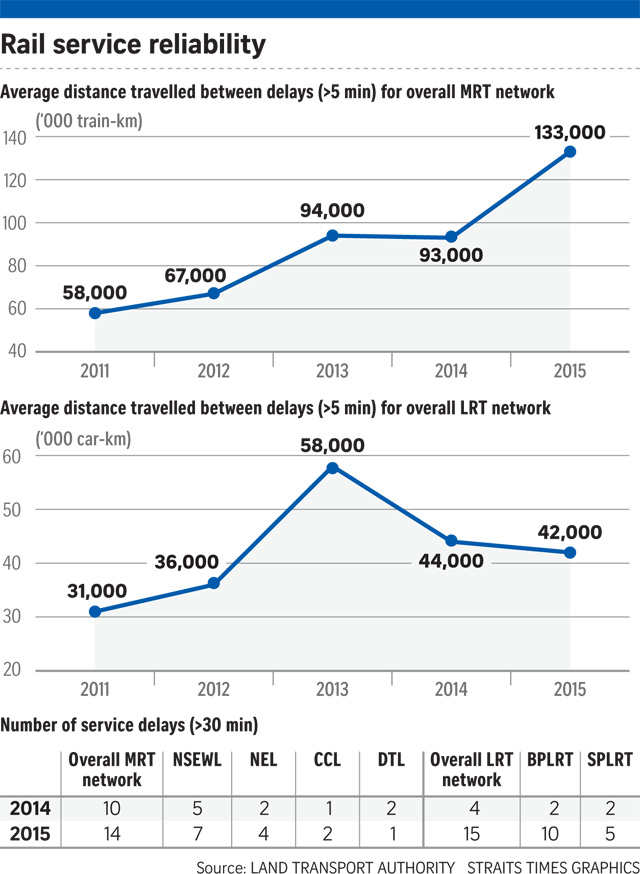Big disruptions jump by 40 per cent in 2015; but trains travelling longer between delays, which indicates greater reliability
There were 14 major breakdowns on the MRT network last year – an increase of 40 per cent from the previous year, the Land Transport Authority announced on its website yesterday.
Meanwhile, the number of such breakdowns, each lasting more than 30 minutes, on the LRT system nearly quadrupled to 15.
For the MRT, only the newest line – the Downtown Line – posted a drop in the number of major disruptions. All others saw an increase, with the oldest – North-South and East-West lines – accounting for half the total of 14.
This figure is higher than that in 2011, when two massive breakdowns triggered a public inquiry and a multibillion-dollar asset renewal programme that will take at least two more years to complete.
There were nine major MRT breakdowns in 2011.
As for the LRT system, the problematic Bukit Panjang LRT, which has broken down repeatedly since day one in 1999, chalked up 10 major incidents – up from two in 2014.
Despite the big breakdowns, the rail system was more reliable than it has been since 2011.
 Last year, a train clocked an average of 133,000km before a delay of more than five minutes occurred. This was up from 93,000km in 2014 and 58,000km in 2011.
Last year, a train clocked an average of 133,000km before a delay of more than five minutes occurred. This was up from 93,000km in 2014 and 58,000km in 2011.
Nevertheless, the 133,000km is still less than half the distance clocked by Hong Kong’s MTR trains between delays.
Of the various lines, the North-East Line was the most reliable, averaging 213,000km between delays.
The LRT network, however, posted an overall dip in reliability by averaging 42,000km between delays. This was down from 44,000km in 2014 but up from 31,000km in 2011.
Dr Walter Theseira, an economist at SIM University, said: “The overall picture is that rail reliability is steadily improving. However, it’s unfortunate that major breakdowns, which tend to inconvenience commuters to a much greater extent, have not improved in recent years.”
Dr Theseira said it is not economically feasible to achieve a state of zero defect.
“The question is whether we have put, or are putting in enough spending on maintenance to bring that probability of disruption down to an acceptably low level,” he said.
“I believe the public does understand this and will accept a low, but not zero, level of breakdowns in the system. However, I think what disturbs the public is the fact that some breakdowns could have been avoidable.”
National University of Singapore transport researcher Lee Der-Horng said the declining number of minor disruptions was “a positive sign”.
But he noted that the Circle Line was the only MRT line that showed a deterioration of overall reliability from 2013.
“This requires higher attention,” Dr Lee said, explaining that since this line is a connecting line for commuters from the other trunk lines, any disruption will have “a spillover effect” on service on the major lines.
christan@sph.com.sg

This article was first published on April 5, 2016.
Get a copy of The Straits Times or go to straitstimes.com for more stories.


























































